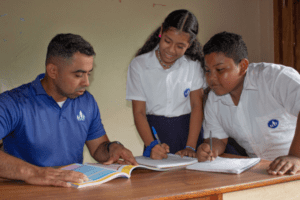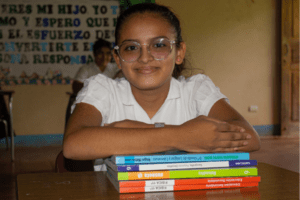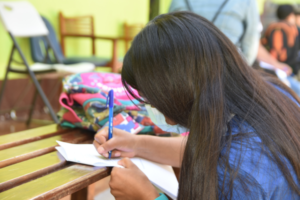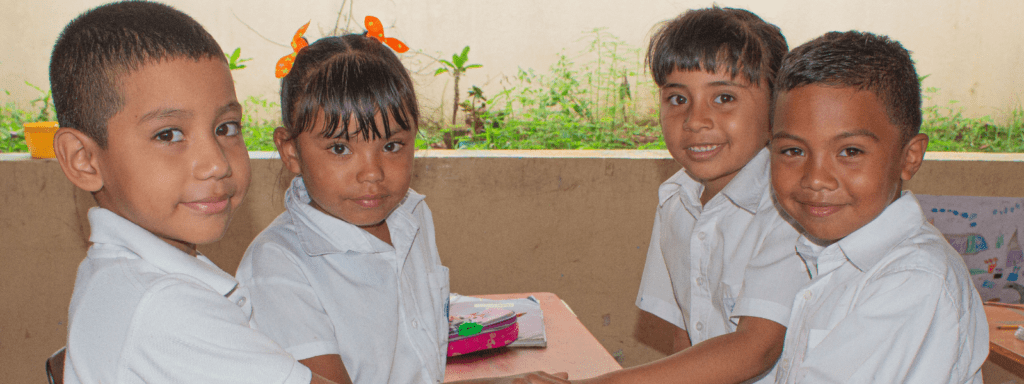Education as a Human Right
Quality education, including access to it, is not just a fundamental human right, enshrined in article 26 of the Universal Declaration of Human Rights, but a powerful catalyst for sustainable development. Education is the foundation of more peaceful, just, and sustainable societies and a force that permeates every facet of our daily lives and overall prospects. Moreover, when effectively shaped and implemented, education becomes a long-term investment for development with increasing returns for society. However, governments, international organizations, and local communities must collaborate to implement targeted strategies, address socio-economic disparities, and create an inclusive educational environment for all. The Convention on the Rights of the Child stipulates that countries must make higher education accessible to all. The lack of educational access is a multifaceted challenge, hindering the development of millions of children and young adults. While progress has been made in various parts of the world, Latin America and the Caribbean continue to grapple with significant challenges in providing accessible and high-quality education, exacerbating existing issues in the region.

Infrastructure and Resources
In many Latin American countries, inadequate infrastructure and insufficient resources hinder the delivery of quality education. Remote and rural areas in particular,often face the brunt of this issue, with schools lacking basic amenities such as proper classrooms.This leads to overcrowded conditions and presents an obstacle for students to focus and learn effectively. Numerous schools in Latin America lack access to modern educational tools and technology, putting students at a disadvantage in terms of digital literacy.
Economic Disparities
Economic disparities contribute significantly to the educational divide. Families with limited financial means struggle to afford the associated costs of education, such as uniforms, textbooks, and transportation, leading to a higher dropout rate among economically disadvantaged students. In some cases, children are compelled to engage in informal labor to contribute to family income, preventing them from attending school on a regular basis. This is how an unfortunate feedback loop is formed whereby economic inequality leads to a lack of educational access, and the latter in turn to the former.

Gender and Racial Inequality
Gender disparities persist in Latin American education systems, particularly in rural areas, societal expectations may prioritize boys’ education over girls’, particularly in conservative communities. Girls face challenges such as early marriage, cultural biases, and lack of sanitary facilities, which can hinder their access to education. Indigenous and minority populations encounter cultural and linguistic barriers in the education system. The curriculum may not be inclusive of their cultural heritage, and language differences can impede effective learning. Addressing gender and racial inequality is crucial for achieving SDG #4.
Quality of Education
While access is a critical concern, the quality of education also poses challenges. Outdated curricula, inadequately trained teachers, and a lack of emphasis on critical thinking skills hinder the development of a well-rounded education system.
The journey towards achieving SDG #4 in Latin America is complex and multifaceted. The lower secondary education completion rate, an indicator of SDG #4, is calculated as the number of new entrants in the last grade of lower secondary education, regardless of age, divided by the population at the entrance age for the last grade of lower secondary education.The long-term objective for this indicator is a value of 100. Mexico and Peru are on track with a value of 90.53 and 99.83 respectively, followed by Bolivia with a value of 89.18 almost reaching the target. Clearly off-track on the lower secondary education ratio are Honduras with 46.73, Guatemala with 54.56, Nicaragua with 66.42, the Dominican Republic with 69.45 and El Salvador with 71.21, unfortunately there is no data for Haiti.
The Responsibility of NGOs
Governments, NGOs, and international partners must continue their collaborative efforts to overcome barriers, ensuring that every child has the opportunity to receive a quality education. Education at NPH embodies a holistic approach that empowers students to reach their potential in mind, spirit and body by addressing the specific needs of diverse populations and embracing innovative solutions. At NPH, teenagers participate in youth empowerment groups which work on improving their self-esteem and self-image, developing their life skills, improving self-confidence, and becoming agents of change for themselves and others. NPH provides parents and youth with access to education and vocational training, enabling them to develop marketable skills and increase their employability. This empowers them to secure better job opportunities and improve their families’ financial situations. Each and every day, the NPH programs strive to carry out Father Wasson’s vision that he shared when he said, “Education will take my children out of the poverty into which they were born.”
An Overview of Education in Latin America
Education in Mexico
Mexico still faces challenges with a large percentage of children not completing their basic education due to economic factors. While urban areas boast relatively well-developed educational systems, rural regions suffer from a lack of infrastructure, qualified teachers, and resources. Addressing these disparities requires targeted policies and investments to ensure education reaches every corner of the country. At NPH Mexico, we are proud of the 116 children and youth who graduated in 2022 from all different grades.In November, university students celebrated their graduation with an emotional event, and are now starting their professional careers as accountants, engineers, dental surgeons, nurses, software developers, finance and gastronomy, amongst others.
Education in Honduras and Guatemala
These Central American countries share similar challenges, including high poverty rates and political instability, highlighting the complex landscape of Education in Latin America. In Guatemala, home to a significant indigenous population, access to education is a pressing concern. Language barriers, poverty, and a historical lack of investment in rural areas contribute to the problem. To bridge the gap, initiatives promoting bilingual education, community involvement, and targeted support for indigenous students are crucial. A big success at NPH Guatemala is the new family-strengthening approach within the NPH OneFamily program.
This new concept is called Primary Prevention, a form of preventive aid to support families who are struggling to ensure an education for their children, especially in rural areas (where girls in particular lack educational access).Honduras faces a dual challenge of high poverty rates and widespread violence, both of which impede access to education. The country needs comprehensive strategies to address economic disparities, improve security, and create an environment conducive to learning. The Vocational Center reopened at NPH Honduras with courses offered to young people from nearby communities to bring education where it’s most needed.
Education in El Salvador
In El Salvador, where a history of civil conflict has left lasting scars, the education system struggles to break the cycle of poverty and violence. Focused efforts on enhancing school infrastructure, teacher training, and community engagement are essential for creating a brighter future for the country’s youth. NPH implemented many changes in the lives of the children and youth at NPH El Salvador. A great achievement in 2022 was to have 90% of students return to take in-person classes while we maintain health protocols against COVID-19. We have always stressed the importance of education for our children and youth, offering them a pathway to learn skills to become professionals.
Education in Nicaragua
Political instability in Nicaragua further compounds the challenges that are already being faced. The country needs stable governance, increased investment in education, and efforts to rebuild trust in the educational system. Addressing these issues is crucial for ensuring a stable and prosperous future. At NPH Nicaragua, 2022 was a year of success in the field of education. NPH has been recognized by the Ministry of Education for its outstanding performance, discipline and adherence to all educational activities. Our noteworthy accomplishment in 2022 lies in the substantial number of 260 graduates, which holds significant importance for NPH Nicaragua. This achievement serves as a testament to the collaborative efforts of all our dedicated employees involved in the education of these children.
Education in Haiti and the Dominican Republic
The island of Hispaniola grapples with economic challenges, and Haiti, in particular, faces significant difficulties in building and sustaining a functional education system. Political instability in both countries has also impacted educational development. Haiti, a nation frequently plagued by natural disasters, faces additional hurdles in providing consistent education. Despite the economic and political situation in Haiti, NPH programs, both residential and community-based, continue to operate to help the boys and girls who live there. Rebuilding efforts should prioritize constructing resilient schools, training educators, and fostering a sense of community resilience to ensure the continuity of education in the face of adversity. In the Dominican Republic, economic disparities persist despite the country’s thriving tourism industry. Efforts should be directed towards ensuring that the benefits of economic growth reach all segments of society, with a focus on quality education for all.

Education in Peru and Bolivia
In the Andean countries of Peru and Bolivia, remote mountainous regions struggle with accessibility issues. Indigenous populations often face discrimination, limiting their access to quality education, highlighting the challenges of Education in Latin America. Peru faces challenges in bridging the educational gap between urban and rural areas. Investment in infrastructure, teacher training, and policies that address the unique needs of rural communities is crucial for fostering inclusive education. In 2022, the Higher Education Program at NPH Peru continued to support older youths in their university studies and transition to adulthood.
Our commitment to promoting education and social inclusion extends to our program for children and youth with disabilities. This initiative aims to enhance their education and facilitate their integration within their communities. Bolivia’s diverse cultural landscape poses challenges in providing inclusive education. Embracing cultural diversity, incorporating indigenous knowledge into the curriculum, and addressing economic disparities are vital steps for NPH towards ensuring education reaches every child.
NPH’s Commitment to Breaking the Cycle of Poverty
NPH is committed to breaking the cycle of poverty through education. NPH envisions a world in which our students reach their individual potential to serve their communities, and recognizes that contributing productively to society depends on the unique abilities of each student. With our schools and educational programs, we ensure that children have access to quality education. Over 3,300 children from low-income households and vulnerable communities attended schools in 2022. This empowers them with the knowledge and skills needed for a brighter future. As children grow older, NPH helps them transition into adulthood by providing vocational training and life skills development. This equips them with practical skills that enhance their employability and independence.
NPH ensures that children receive their universal right to education by accepting students’ distinct learning needs and adopting a personalized, inclusive approach that recognizes past hardships and transforms them to fulfill their unique potential. All the girls and young women in our homes and schools have the same opportunities as the boys to finish their primary education and attend university. They are raised as equals in our homes and they are encouraged to cultivate and pursue their dreams. NPH places a strong emphasis on instilling values and character development in the children. We foster a strong connection to religious or ethical principles, as well as a sense of responsibility, compassion, and respect.

